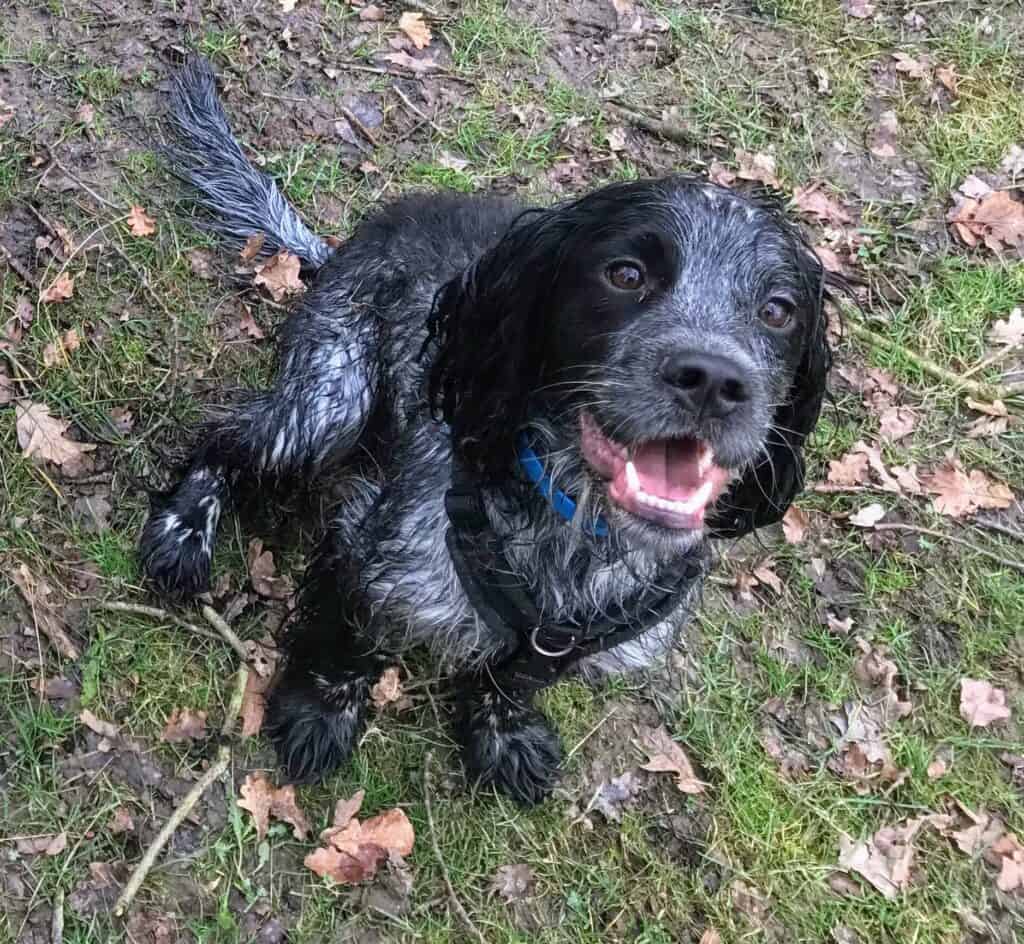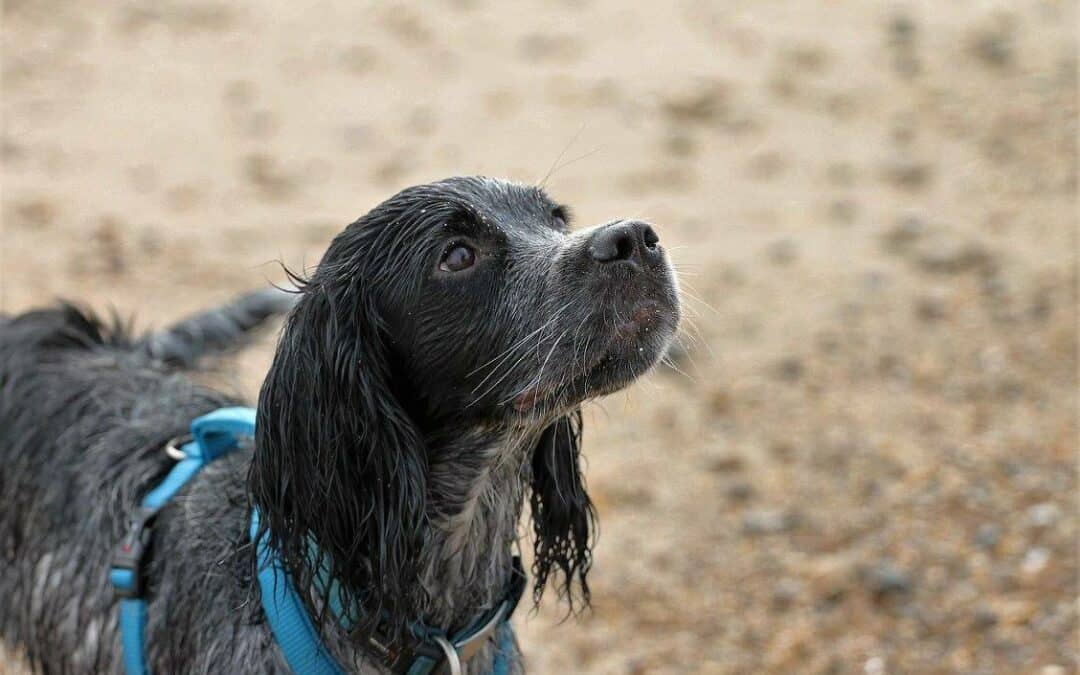How I Lost My Dog
Recently I lost Flint, my working cocker spaniel. Actually, I hadn’t entirely realised I lost him before he reappeared. Teaching the collar grab was the reason I got him back so quickly.
I was moving equipment for Thursday night classes from my back garden to my front garden to load into my van, eventually. Fraggle and Flint like to accompany me on such chores as they like visiting the front garden – Flint likes to sniff for any past visitors, Fraggle likes to watch the birds and the neighbourhood cat through the front fence.
As usual, I visually checked the front gate was shut before I let the dogs into the front garden. I went back and forth bringing equipment through from the back garden, Fraggle and Flint mooched about. Then I realised I needed something else that I had to go hunting for. During the hunt the front door was blown partially shut so I couldn’t see the dogs anymore, but I wasn’t worried, that wasn’t unusual.
When I went back outside, Fraggle was there, but I couldn’t see Flint. I called him, no response, then in dawning realisation I saw that the front gate was slightly open. Just enough of a gap for a skinny, nosy cocker to slip out of. As I walked to the gate, my neighbour appeared walking Flint back by his collar. I hadn’t even had the time to worry before he was back!
That’s when I realised there was an Amazon parcel sitting by the front door. Probably we had a delivery just before we went out the front and the gate hadn’t latched properly, so although it looked closed, the same gust of wind that closed the front door, opened the gate.
Lesson learned – check the gate is latched when you let the dogs out.
However, the moral I want you to take away from this story is that if I hadn’t taught Flint to accept people grabbing his collar and using it to walk him around, my tale could have been different.

Grabbing my dog’s collar was a non-Incident for my neighbour
My neighbour was very nonplussed about the whole thing when I brought him over some beer to say thank you. He told me that he was cleaning out his car on his drive and saw Flint’s nose poke around the corner of his hedge. Realising it wasn’t the dog who lives opposite him (also a blue roan cocker), he read the collar on his tag and walked him back to me.
Him not mentioning grabbing Flint’s collar or whether it was difficult to read the tag, leads me to believe that it wasn’t difficult at all to catch Flint and read his tag and then walk him back. Which is exactly what I want.
Will It Make Your Dog More Easily Stolen?
I teach a collar grab in two of my regular classes and often I get asked whether it can make it more likely that a dog could be stolen.
I guess it’s a fair question. We hear about the rise in missing, presumed stolen dogs a lot. But I also see a lot of news about dogs that have gone missing from walks having bolted and that people should not approach because the dog can’t be caught.
For me, I think it’s more likely that my dogs will need catching than someone will steal them. And because they might need catching, I want them to be OK with being grabbed. Potentially by a nervous or scared person who might grab with less thought than they would otherwise because they are panicking.
The scenario I always imaged however was my dogs running across a road and me yelling at someone to grab them so they don’t run back. Yes, I teach an emergency stop, but well, I’m also imagining that I’ll be panicking too. But waltzing out the garden and visiting the neighbours works as an example too – thank you Flint for giving me a real life example for the future.
Reasons for Teaching a Collar Grab
You can catch your dog more easily
I think we’ve gone over that already, but I’m not the only person who thinks it’s important that your dog is used to different people grabbing his collar. Pat Miller CBCC-KA CPDT-KA, agrees with me that teaching a collar grab is a fundamental skill you should train.
It’s easier to put your dog back on lead
Does your dog stay just out of reach or actively run away from you when you want to put them on lead? A collar grab behaviour can help you with that. You can teach your dog to put their collar on your hand if you like.
You can take your dog’s collar and move them without a fight
My normal go to for getting a dog to move is to use a hand touch behaviour, but sometimes leading them by the collar is necessary. I prefer to take time teaching my dogs that this is an enjoyable activity that pays off. Then it shouldn’t be a struggle just when I need it most. My elderly dog can’t see my hand target very well anymore, so I’m relying on the slight pressure from a finger in his collar more and more. If I hadn’t taught him about a collar grab and moving into pressure, I’d probably have to use greater force than I do. Right now it’s enough to place my finger lightly on the edge of the collar and show the direction I need him to move in. I don’t even need to take hold of it.
You can grab your dog’s collar to stop him doing something
Talking of my elderly spaniel Breckin, sometimes he attempts to do something he physically can’t, mainly because he enjoys taking years off my life, I’m sure. For instance, he still attempts to jump up onto the sofa despite him landing in a heap on the floor the last few hundred times he has tried it. We can grab his collar to stop him when we see him lining up – and it is a dive and grab – without him freaking out. Which is good because he tries it multiple times a day *sigh*
How to Teach a Collar Grab
Presuming I’ve convinced you that teaching a collar grab is a useful and worthwhile behaviour to train, this is how I teach it:
- Set yourself up so you are standing or sitting in front of your dog. Have food in one hand.
- Move your empty hand towards your dog’s collar.
- Move it slowly and gently at this stage. Just aim to get the tip of your finger to brush the collar.
- Then while your fingers are touching his collar, with your food hand, give your dog a treat, then another one, and then bring both hands back down to your side.
- It’s important that the non-food hand moves towards the collar first.
- If your dog moves away as you reach towards him, stop reaching earlier.
- Just stop your hand in midair as if you were going to touch his collar and then give him the treats.
- Repeat this several times.
You are looking for the moment your dog sees/feels your hand, and he actively looks for the follow up treats. Your dog might just lean towards the treats, or he might start wagging his tail after you touch his collar, or you might get a full on body wag. It depends on your dog.
I like to stay at any stage until I see behaviours that I would call anticipation of good things. Once you’ve got this, you can increase your criteria.
Break down the stages
Work through the stages listed below gradually, making sure your dog is comfortable at every stage. If the leap between stages seems too big for your dog, break it down and find a way of making it just a smidgen harder. Fine slices will get you to your destination quicker rather than trying to take big hulking bites that cause you to choke.
- One finger touching collar
- Two fingers touching collar
- Three fingers touching collar
- One finger hooked under collar
- Two fingers hooked under collar
- Take hold of collar gently
- Hold collar and shake it slightly
- Taking hold of collar more roughly
- Move hand towards collar more quickly
- Taking hold of collar and applying pressure for dog to move one step forward
- Taking hold of collar and applying pressure to walk dog 2 paces
- Take hold of collar and walk dog several paces
- Hold the collar and move more quickly
- Take hold of the collar while talking
- Take hold of the collar while talking more loudly
- Walk towards dog and take hold of collar
- Walk towards dog more quickly and take hold of collar
- Run towards dog and take hold of collar
- Work through the list again with a new person your dog knows
- Work through the list with a person your dog doesn’t know so well
- Etc.
I like to think about what I’m likely to do if I’m panicked. I’m probably going to run, yell, grab roughly, pull dog towards me, run away while holding collar etc. Then I actively work through a systematic program that gets me towards that goal.
You can reap dividends without finishing the entire program
Now have I worked all those things in for my collar grab game with all my dogs? – absolutely not. Flint is only at the stage of me walking towards him, taking his collar and leading him away. He’s not a fan of pressure on his collar still. And yet the work we have done was enough that my neighbour thought nothing of leading him home.
I’ll be working with him more on it now, because that experience might have set him back a little.
You can try the collar grab game yourself and tell me how it goes.
If you want more tips like this become an insider and join our newsletter family today! As a subscriber, you’ll gain access to a treasure trove of knowledge, actionable tips, and a community that shares your passion for helping dogs thrive. Sign up now and be the first to receive updates that can make a world of difference for your four-legged friend.

